-

-
College Greenspace
by: Providence Christian Colleg
Summary of “Recognizing Campus Landscapes as Learning Spaces By: Kathleen G. Scholl & Gowri Betrabet Gulwadi
In this article, Kathleen Scholl & Gwori Gulwadi opens the discussion around 20.4 million students attending colleges and universities and how the number continues to grow. This growing student population challenges university to reframe their teaching methods and campus environments of today’s college population. The experimenters propose that “colleges and universities should utilize their natural landscape as a learning resource for students” (Scholl and Gulwadi 1).
As the article continues, Scholl and Gulwadi examine the historical background of college campuses. Many of America’s colleges and universities are located in rural areas due to their origination being centered around creating a seclude place apart from city life, in addition; the land act of 1862 required labs and scientific research buildings to be built. This innovation created the optimum learning environment. An early land space designer, Fredrick Olmstead stated ““natural scenery employs the mind without fatigue and yet exercises it; tranquilizes it and yet enlivens it” (Scholl and Gulwadi 54). The amount of land is still significant to college and universities today. As institutions continue to evolve and campus landscapes become more urbanized, the appeal of greenery will continue to pose importance to colleges overall learning environment.
Scholl and Gulwadi evaluate the definition of landscape better understand its place in the campus setting. In the article nature is defined as ““physical features and processes of nonhuman origin that people ordinarily can perceive… together with still and running water, qualities of air and weather, and the landscapes that comprise these and show the influences of geological processes” (Scholl and Gulwadi 55). This definition allows for the campus environments to provide the perspective of viewing campus settings as part of the environment. By this perspective being taken into consideration, the most inclusive and eco-friendly landscape can be achieved for students attending colleges or universities. The researchers have noted that many times students experience loss in cognitive functions such as concentration and focus, impulse, inhabitation and also memory due to fatigue and overuse (Hartig, et al., 2014; Kaplan & Kaplan, 1989). When colleges and universities provide green spaces on their campus, these ailments that plague most college students and can alleviated simply by being surrounded in a natural learning space. Consequently, students who have a nature setting on their campus experience less stress and hostility. A campus that caters to depleting the cognitive aliments of students being stressed and overwork through a natural environment, will then create an institution of well rounded students.
The traditional setting of a college campus has been created learning environments that are no longer concussive to the new age students who attend those institutions. As the technology advances and colleges and universities continue to expand; the addition of natural landscapes or green spaces can provide the students with benefits of being at a high institution of learning but also providing a natural environment to be in touch with mother nature. Scholl and Gulwadi conclusion reinforced the idea that natural green spaces environment is beneficial to student learning.
Scholl, Kathleen G., and Gowri Betrabet Gulwadi. “Recognizing Campus Landscapes as Learning Spaces.” Journal of Learning Spaces 4, no. 1 (July 8, 2015). http://libjournal.uncg.edu/jls/article/view/972.
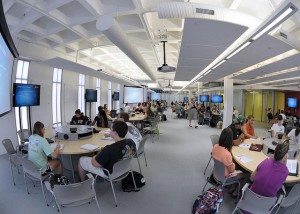
Active Learning enviroment
Summary of “Pedagogy Matters, Too: The Impact of Adapting Teaching Approaches to Formal Learning Environments on Student Learning” – D. Christopher Brooks, Catherine A. Solheim
In this article, D. Brooks and Catherine Solheim examines the how students learn and receive information when taught in an active learning environment. The study began in the fall 2009 on the campus of the university of Minnesota. The experimenters wanted to produce constant data over multiple semesters. So the study was conducted using the same instructor, classroom (student in the ALC), and personal finance course.
Once Brook and Solheim, created the constant they started the active learning experiment, also known as the qusi-experiment. The course –Personal Family Finance converted from a traditional lecture into an active learning environment. In the team learning environment, the students had mandatory class attendance, viewed videos, and other required material before each class. (Brown 54) Also the traditional use of hardback textbooks were nixed from the active classroom setting and now student receive crucial information through technological mediums.
After the active learning approach had been implemented to the personal Finance course, brown and Solheim collected data from one-hundred and eleven students who had been expose to the active learning course in the fall of 2009. The Students were asked at the end of the semester to complete a forty-five question survey on their experience in the active learning environment. Once the data was collected, brown and solhiem observed that the student who took the traditional Personal Finance course in the fall of 2008 received an overall grade of 81.80 and the students who were exposed to the qusi-experiment in the fall of 2009 received an overall grade of 85.50. (Brown 56) These results reinforced the experimenter’s original hypothesis that the active learning approach would increase the grade average of student who were actively engaged in the learning process then those who are not.
In addition to the initial results displayed about the increase in grade point average in students in the active learning course, another explanation is the difference in presentation the course assignments. This is due to the fall 2009 ALC students having been introduce to the assigments in an engaged manner than the traditional learning students. The data collected that students that received engaged approach to major course assignments produced high averages. ALC students received 14.60 percent higher on participation, 5.36 percent on the financial planner, 6.43 percent on case studies, 13.60 percent on the final exam, and 9.31 on various quizzes. (Brown 58)
Fortunately, the final condenses of the qusi-experiment conducted by Brown and Solhiem rendered three conclusions. The first is that the ALC learning approach should be considered in colleges and universities. Secondly, instructors teaching the course should approach the course which an active learning mentality. And the third conclusion is that there is more than ALC method of teaching, and each instructor must find the style and method that is most effective for them as in individual.
As time continues and technology becomes more prevalent in our everyday society active learning approach will be implemented more over time.
Brooks, D. Christopher, and Catherine A. Solheim. “Pedagogy Matters, Too: The Impact of Adapting Teaching Approaches to Formal Learning Environments on Student Learning.” New Directions for Teaching & Learning 2014, no. 137 (Spring 2014): 53. doi:10.1002/tl.20085.
Oakhurst Community community park exemplified the true meaning of a built environment. Oakhurst Community Garden is located at 435 Oakview Rd, Decatur, GA 30030. My visit to the garden was on a Monday afternoon, the air was fresh and brisk. When I began my tour around the garden I noticed the open layout. While standing at the entrance, the majority of the garden’s framework is visible. The first attribute that drew my attention was the graffiti wall. The spray-painted image of the bee pollinating the flower against the red-brick background gave the garden’s main office building a splash of Pizzazz.
Once I fully entered the garden, I was able to view the garden’s main structure: the plots. The plots are the crucial elements of the garden. Residents within in the community tend to their plots, reaping hardy vegetation throughout the entire year. While on the my visit I witnessed a plot growing kale. I was able to see a garden plot in action, growing local and fresh vegetation. This illustrates the true meaning of the garden within the oakhurst community. In addition, the garden processed a have peaceful feeling by the faint sounds of birds chirping and wind chimes. A sacred vibe was revealed deeper through the praying saint located adjacent to the plots. The presence of the saint created the understood feeling that garden is a scared space and the act of growing and producing food can be carried out in a wholesome environment.
My overall experience of Oakhurst Community Garden Provided a new insight on the word community. The energetic and creative energy surrounding the garden demonstrates the general feeling experienced throughout the entire oakwood community. I truly enjoy the garden and will definitely revisit in the spring when the natural beauty of the garden is shining at full capacity.
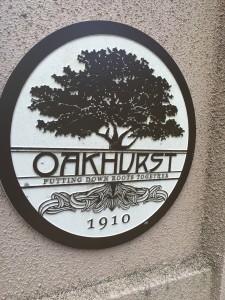
Community Seal
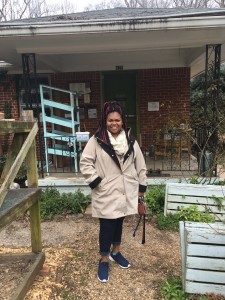
Oakhurst Community Garden
1.The Oakhurst community garden is located within the city of Decatur. This garden serves as green space to provide the resident of this community with a haven to grow an array of vegetation ranging from seasonal fruits and vegetables to decorative flowers. The Oakhurst garden provides the community with true sense of locally grown produce while, still contributing the environmental benefits while living in an urban neighborhood.
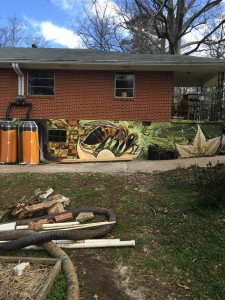
Nature graffiti Mural
2. Upon walking into the garden, on the left side of the garden’s main office building is a graffiti mural. The mural displays a bee in it’s natural function of pollinating a flower. Throughout the duration of the mural, the primary colors yellow and green are produced in many shades of greens ranging from a pastel to a deep rich olive color likewise, to the yellow conforming from the shade of a bee to the golden color of the water pumps. This mural is a representation of a artwork form that usually contains the negative stereotype of vandalism when associated in an urban environment. Instead the art form of graffiti is repurposed so solidify the garden is urbanized while simultaneously capturing the importance of this green space within this community.
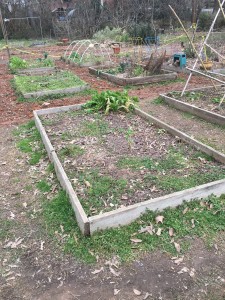
Garden Plot
3. The Oakhurst Garden is set up into individual plots. These plot are managed by community residents who pay annual dues and contribute their time throughout the year to maintain the garden’s upkeep and vegetation. As a result, the community residents are allocated their own individual plots to grow any kind of produce, fruits, or other vegetation on their choosing.

Kale
4. While in the garden, I was able to experience on the plots at work. This particular plot is growing a Kale. The Kale held an appetizing green that demonstrated pure freshness. The Oakhurst garden’s diversity in vegetation throughout the year allows for hardy green like lettuce to prosper despite it being one Georgia’s coldest winter months- January.

Saint
5. In the garden off to side sits this mural of praying saint. The saint’s positioning is adjacent to the community growing plots. While I stood gazing back and forth between the saint and the garden plots a purpose of saint in the was now understood. The saint is the watcher of the garden. This creates a peaceful feeling within the entire garden and a safe place.







